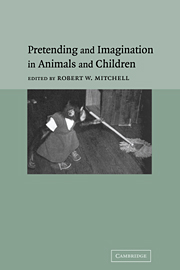Book contents
- Frontmatter
- Contents
- List of contributors
- Foreword by Sue Taylor Parker
- Preface and acknowledgments
- I Historical, developmental, and comparative overviews
- II Pretense and imagination in children
- III Pretense and imagination in primates
- IV Prospects
- 22 Exploring pretense in animals and children
- References
- Author Index
- Subject Index
22 - Exploring pretense in animals and children
Published online by Cambridge University Press: 13 August 2009
- Frontmatter
- Contents
- List of contributors
- Foreword by Sue Taylor Parker
- Preface and acknowledgments
- I Historical, developmental, and comparative overviews
- II Pretense and imagination in children
- III Pretense and imagination in primates
- IV Prospects
- 22 Exploring pretense in animals and children
- References
- Author Index
- Subject Index
Summary
Pretenses appear in six forms of activity in this volume:
self-pretense, as in reproducing the appearance of, feigning, or inhibiting one's own acts and emotions (for play, teasing, deception, communication, or evocation);
object substitution (including replica toy play);
animation of objects (including doll play);
pretending about imaginary objects (supported by real objects or not);
pretending to be (or act like) someone else;
pretending to have (imaginary) companions.
These pretend types are intended to be neither exhaustive nor mutually exclusive, but rather to direct attention to the pretenses observable in animals (or potentially so). All of these activities are much more common in children than in animals, and how to interpret them in either is (as this volume attests) subject to disagreement, providing a fertile field for reflection and investigation. (Imaginative nonpretend actions are discussed in the first chapter.)
In this chapter, I summarize research on pretense and direct attention to future research on animal pretense. A pattern should become evident – scientists interested in discerning pretense in animals need to observe individual animals ontogenetically in order to understand and interpret their behaviors, and also need to employ knowledge of the types of behaviors animals of the observed species use in potentially pretend actions, to discern the precursors of these behaviors (Mitchell, 1986, 1987, 1990). Put simply, extensive longitudinal study incorporating contextual analysis, focal animal sampling, and an (at least partial) ethogram are essential for discerning pretense in animals.
- Type
- Chapter
- Information
- Pretending and Imagination in Animals and Children , pp. 307 - 316Publisher: Cambridge University PressPrint publication year: 2002
- 1
- Cited by



